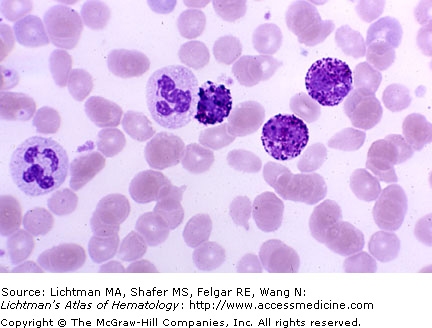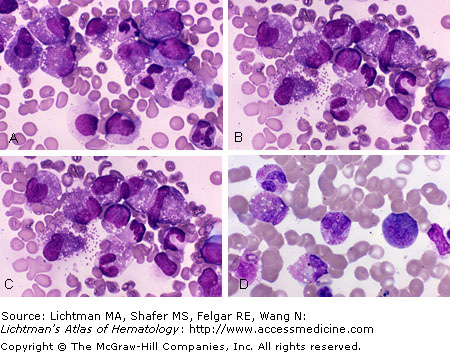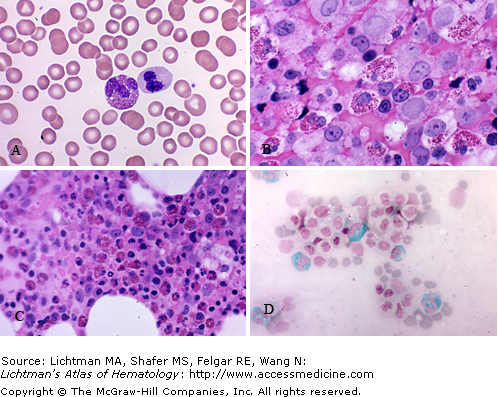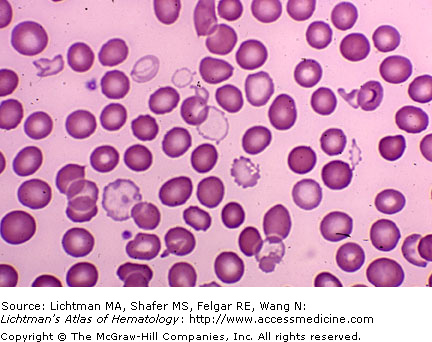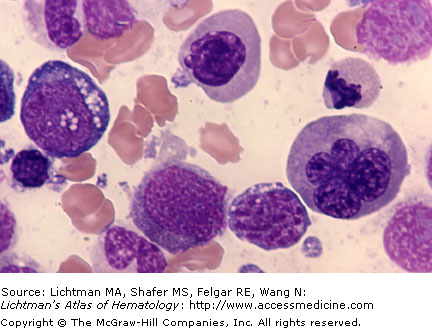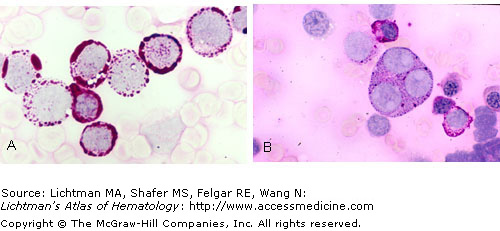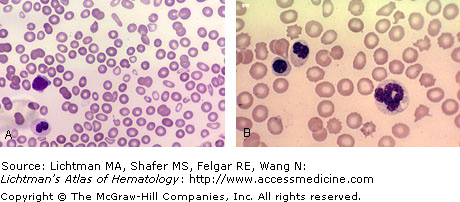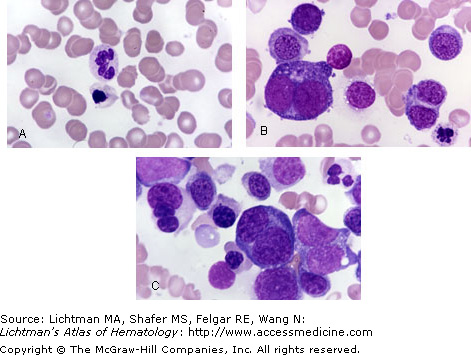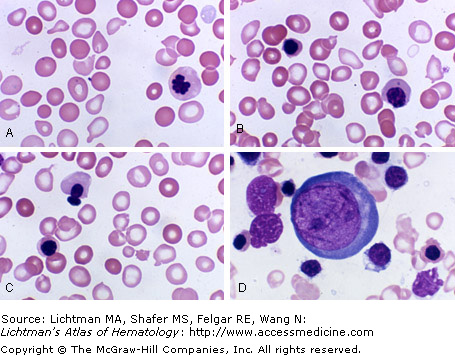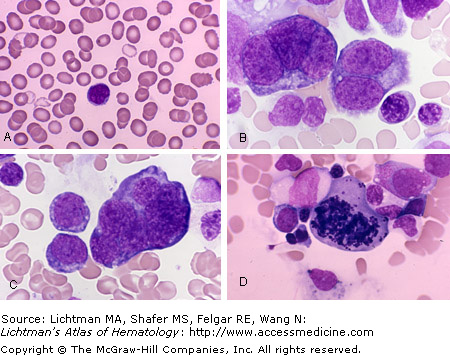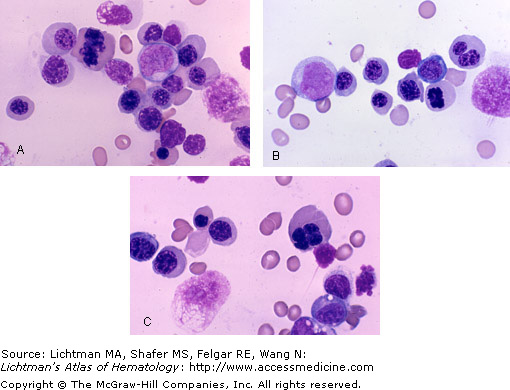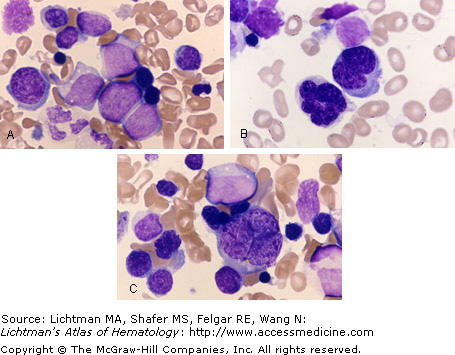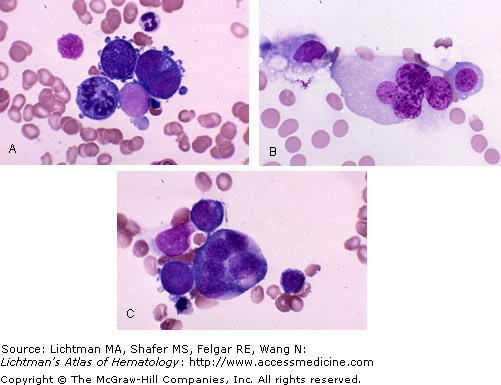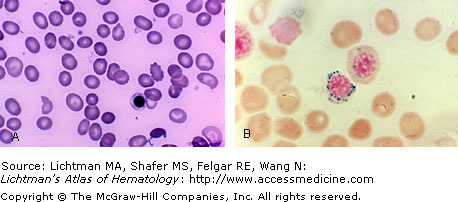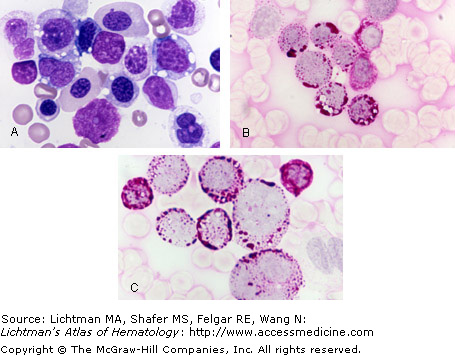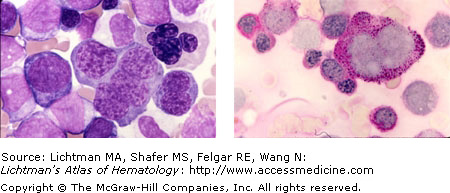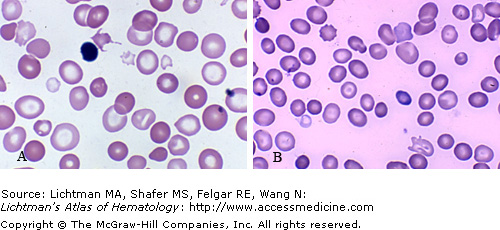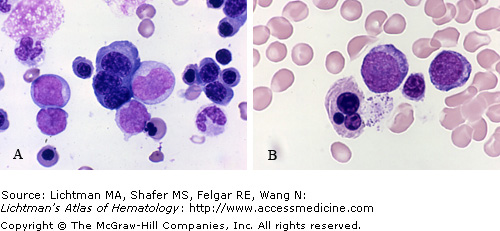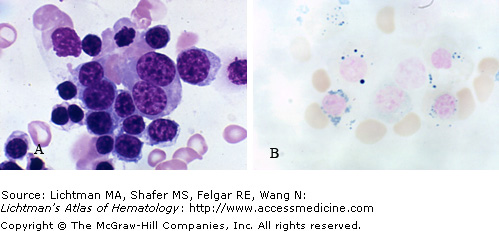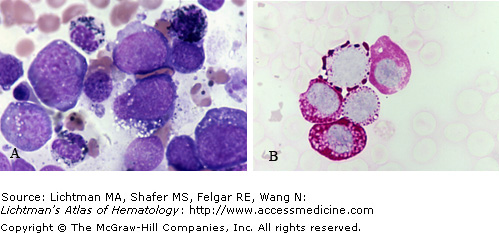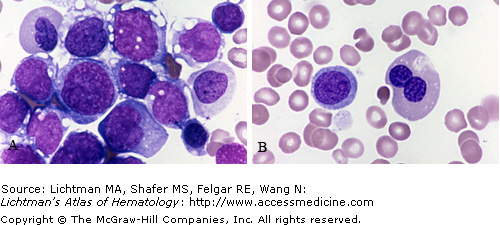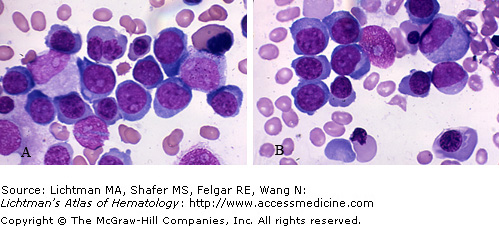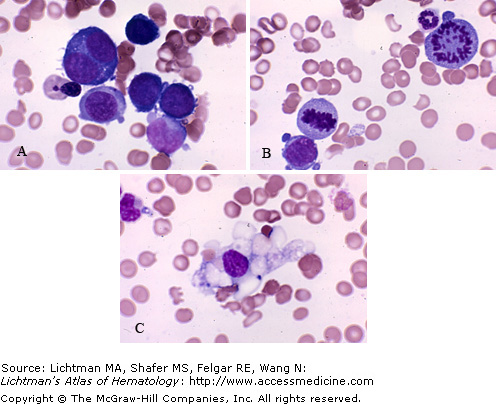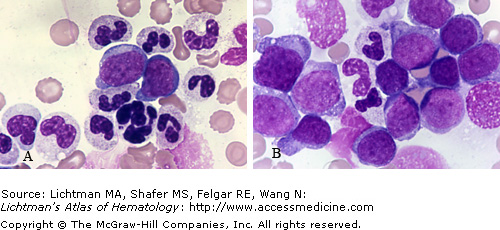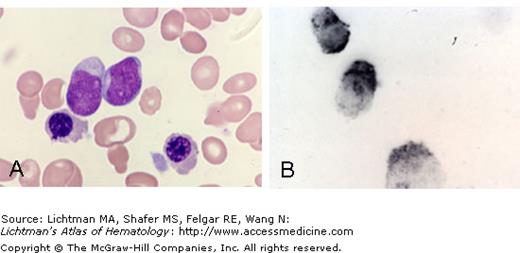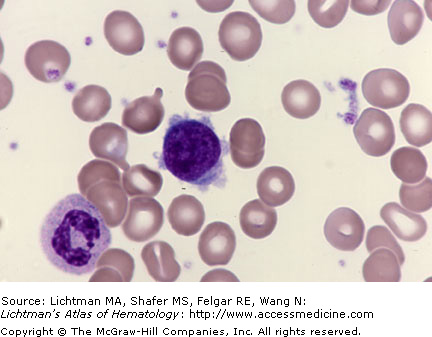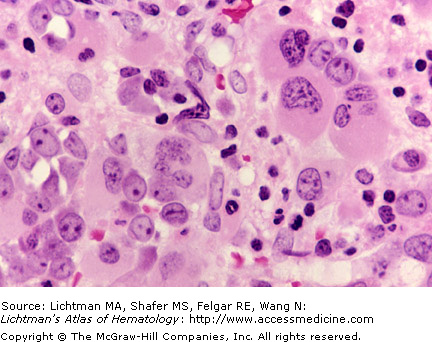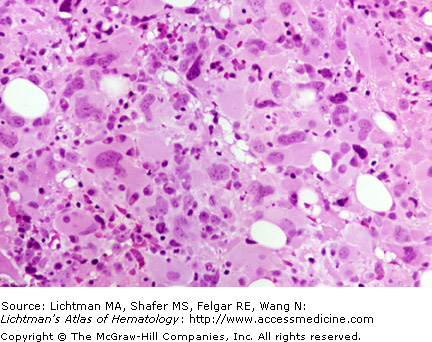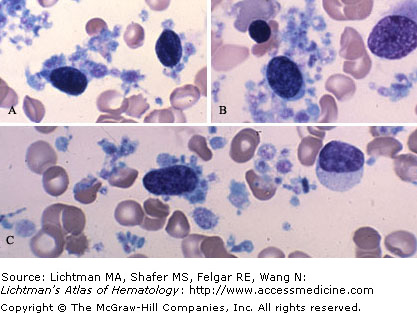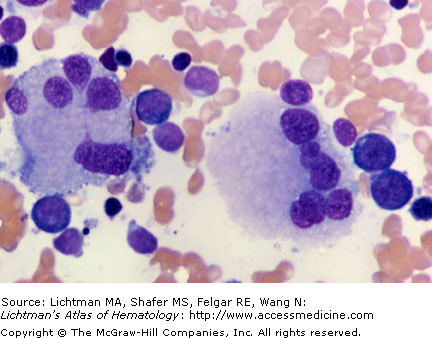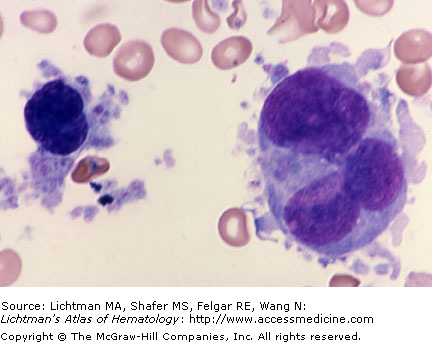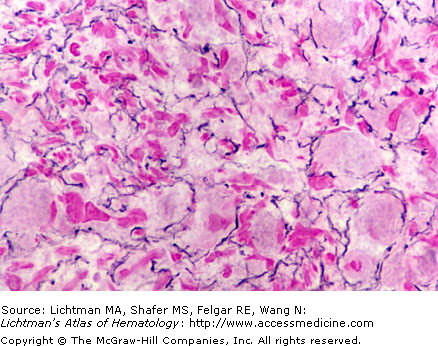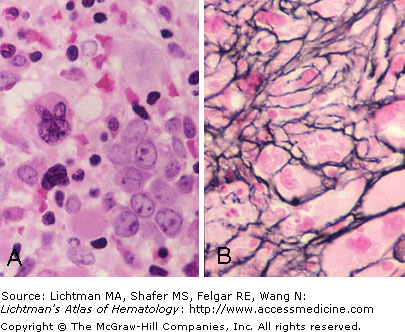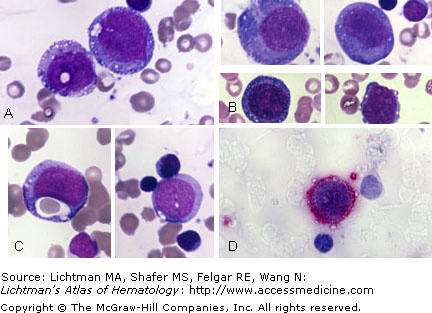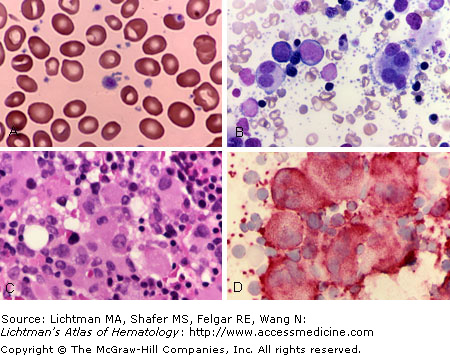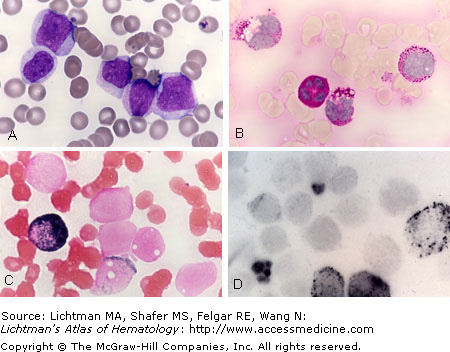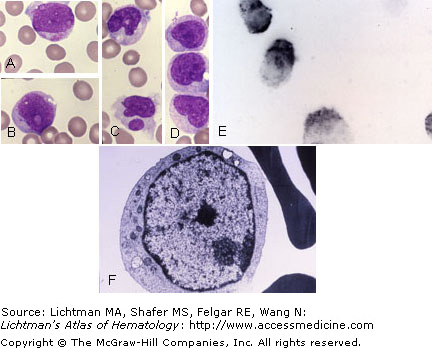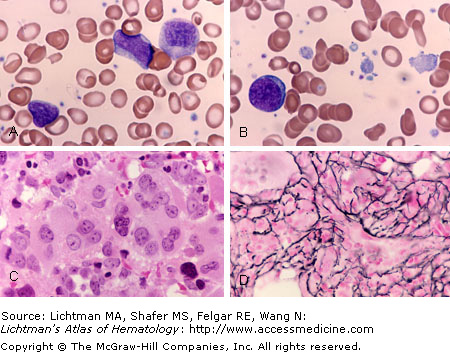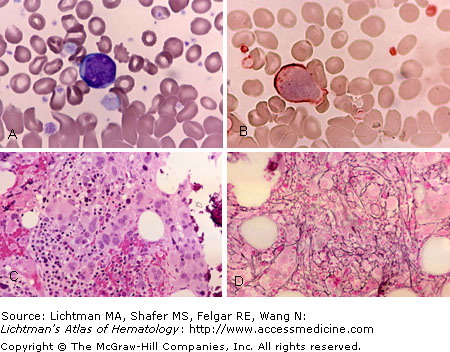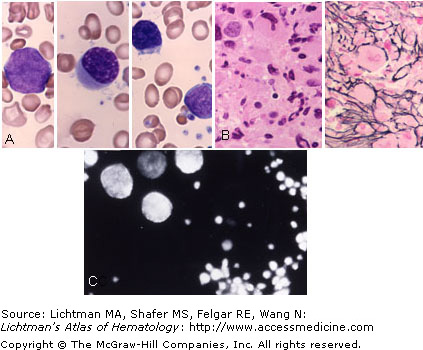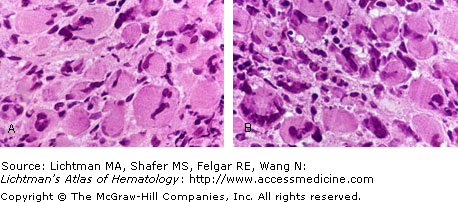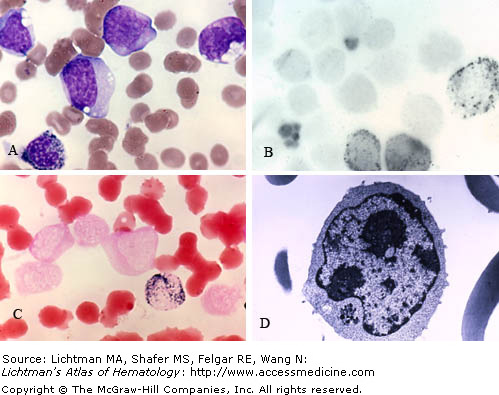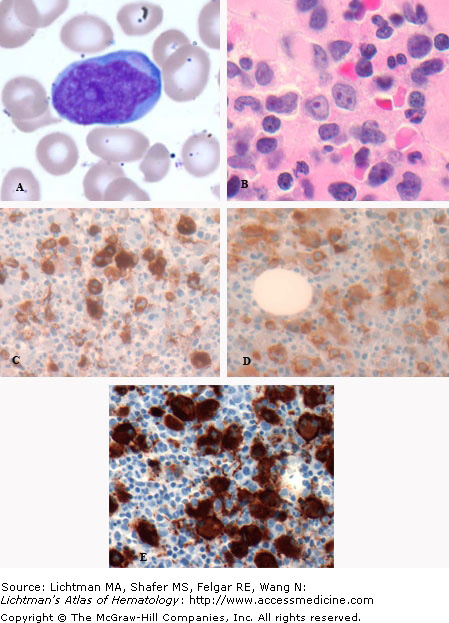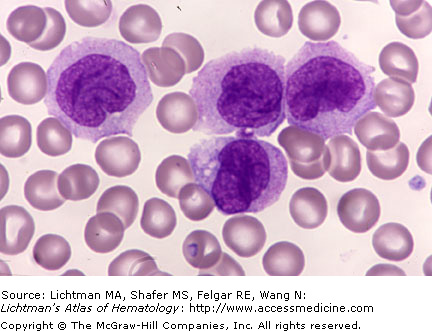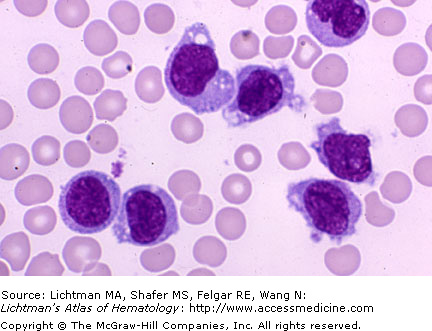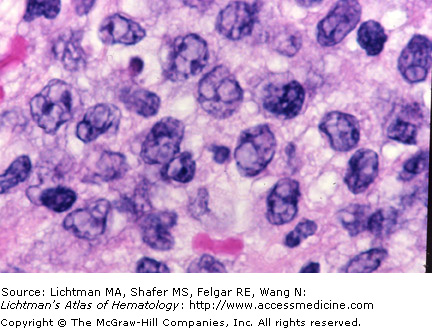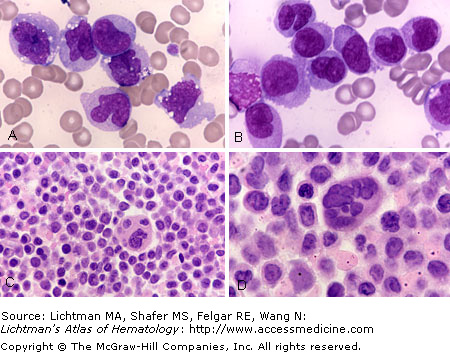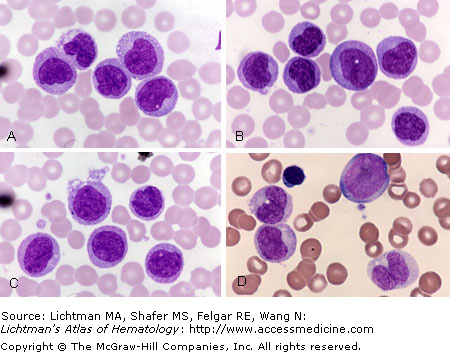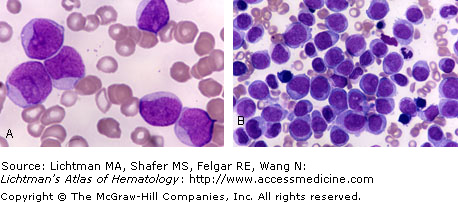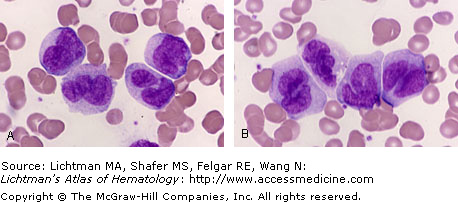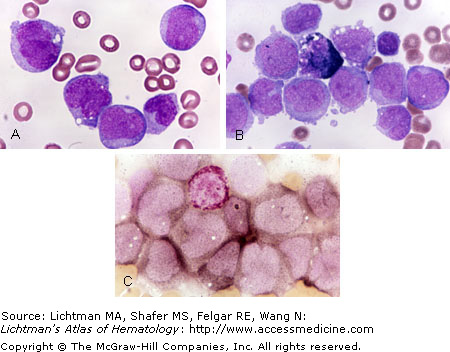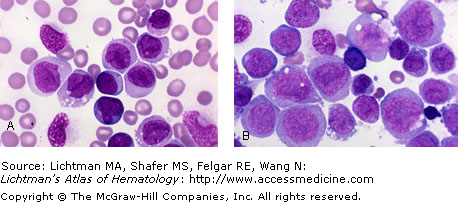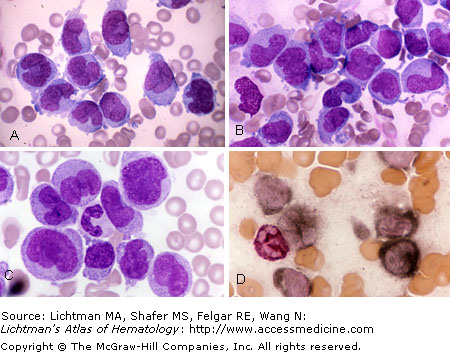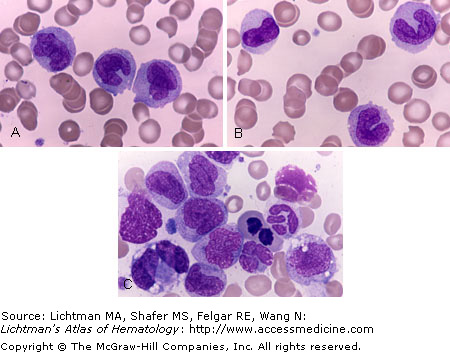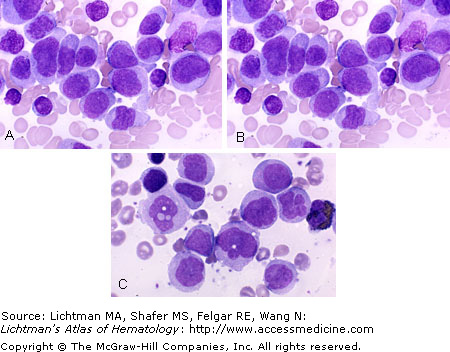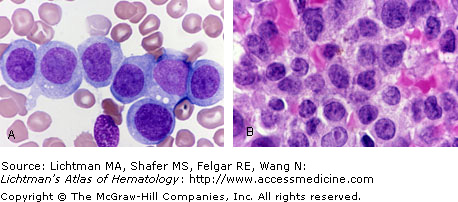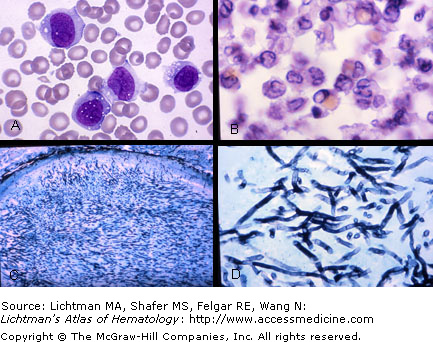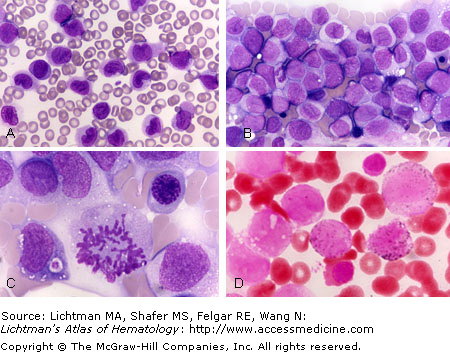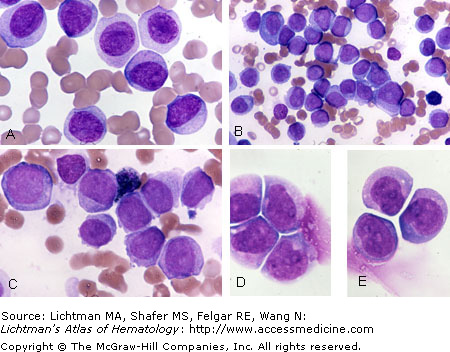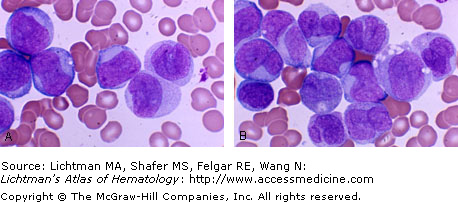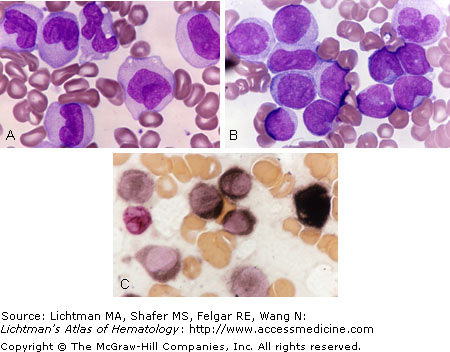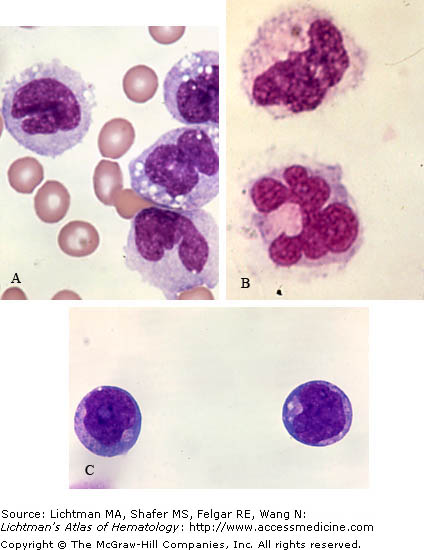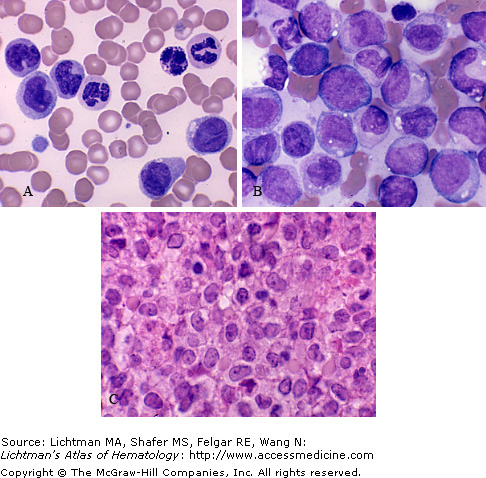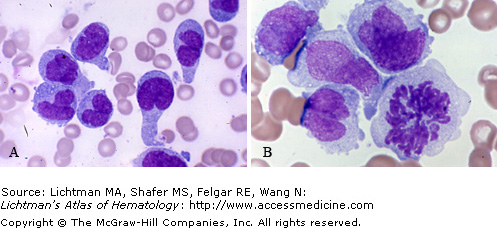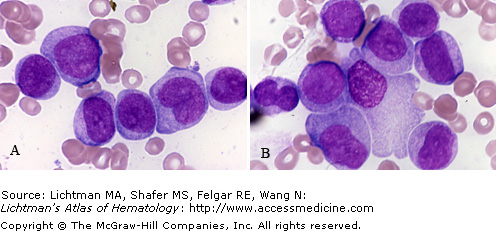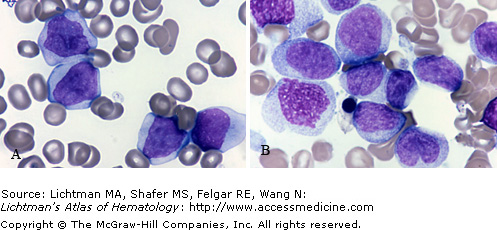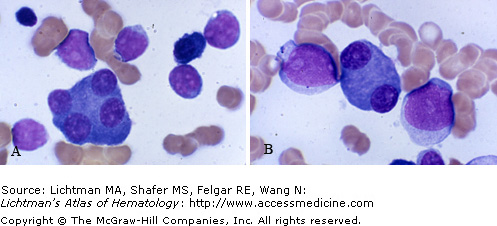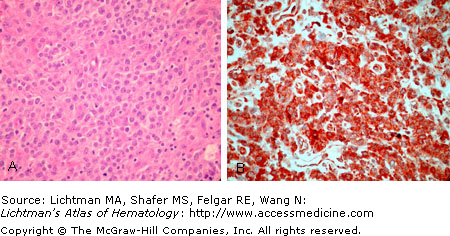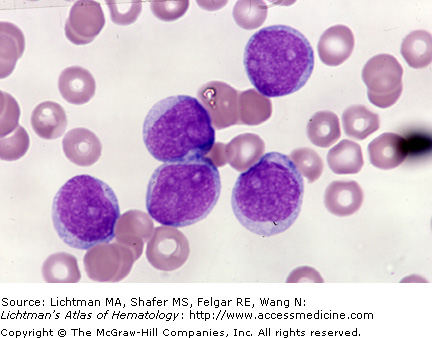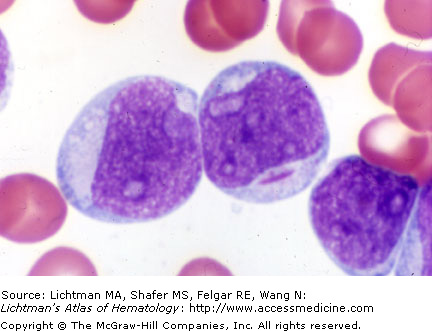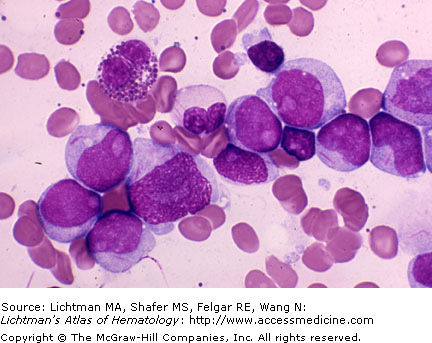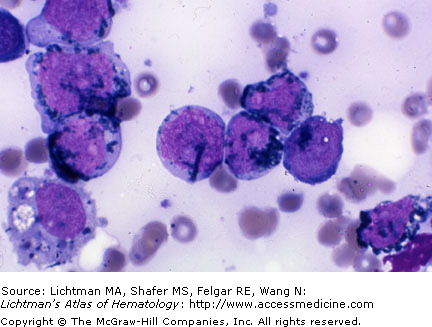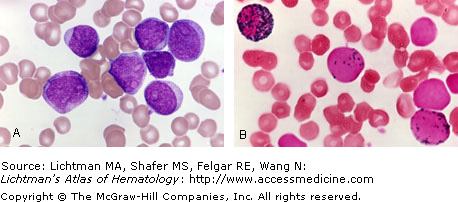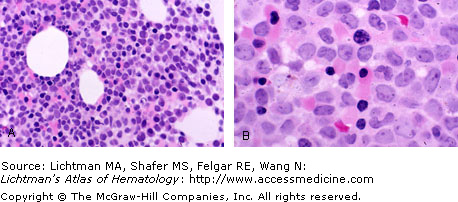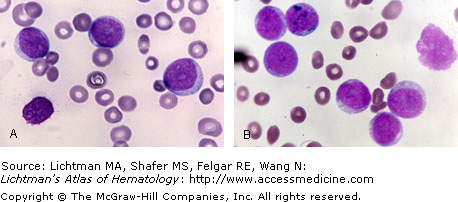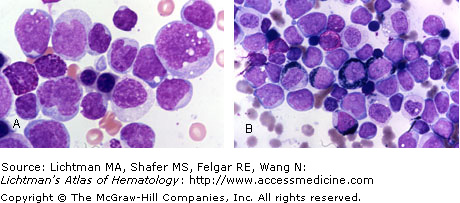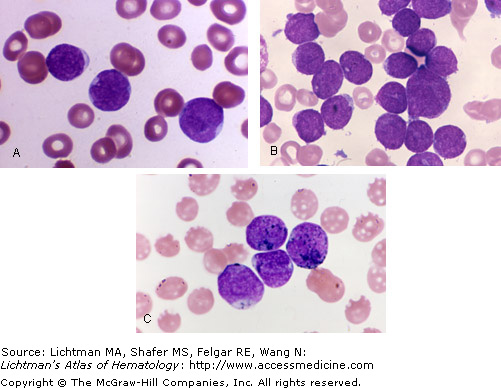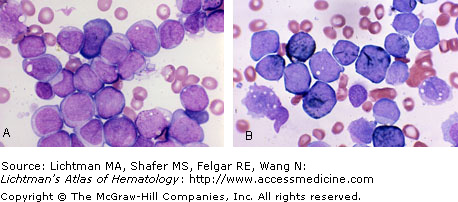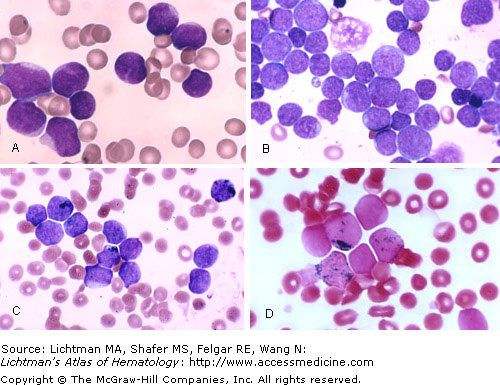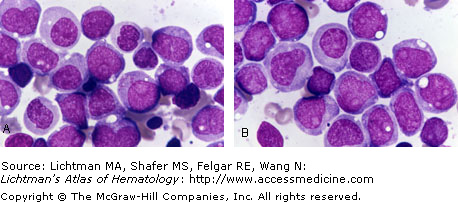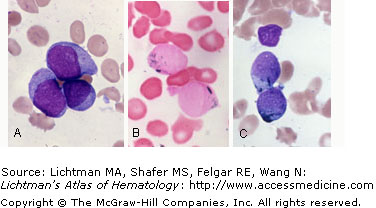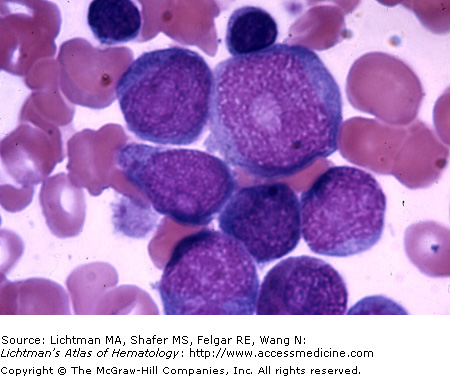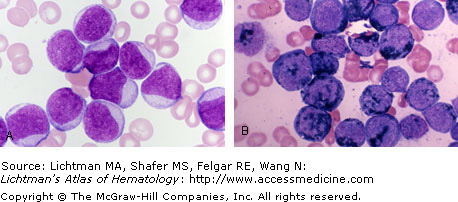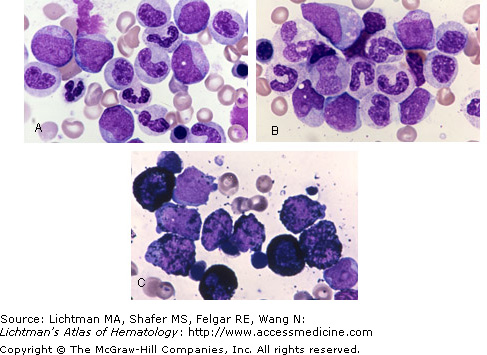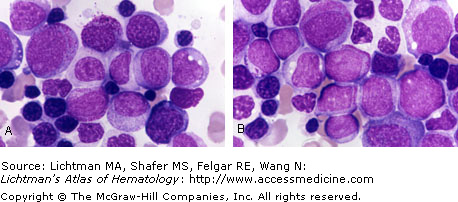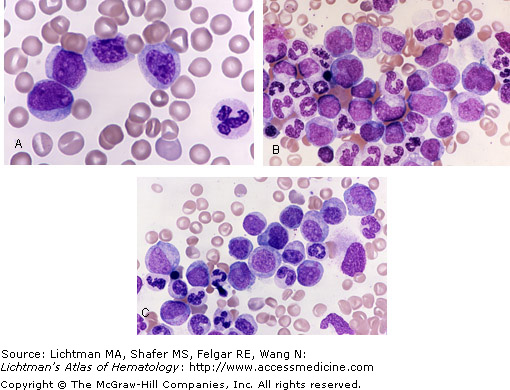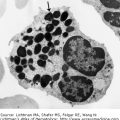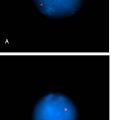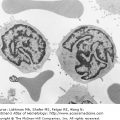VI.A.001 Acute Basophilic Leukemia
VI.A.002 Acute Basophilic Leukemia
VI.A.003 Acute Basophilic Leukemia
VI.A.003
Acute basophilic leukemia. (A) and (B) Blood films. Blasts and immature basophils, the predominant blood cell types. (C) Toluidine blue stain. Upper right shows an unstained band neutrophil. Other three cells are immature basophils. Note metachromatic staining (reddish to purple color reaction with a blue stain).
VI.A.004 Acute Eosinophilic Leukemia
VI.A.004
Acute eosinophilic leukemia. (A) Blood film. Two blast cells, two neutrophilic cells with dumbbell nuclei (pseudo-Pelger cells) and an abnormal eosinophil with five-lobed nucleus. (B) Blood film. Two blast cells, two neutrophilic cells with dumbbell nuclei (pseudo-Pelger cells) and an abnormal eosinophil with five-lobed nucleus. (C) Marrow section. Multiple blast cells and eosinophils in various stages of maturation. (D) Marrow film. Peroxidase stain. Positive reaction (black reaction product) in myeloblasts and immature eosinophils.
VI.A.005 Acute Eosinophilic Leukemia
VI.A.005
Acute eosinophilic leukemia. (A) Blood film. Two segmented and one band eosinophil. (B) Blood film. Very early and late eosinophilic myelocytes. Two neutrophils. (C) Marrow film. Two eosinophilic myelocytes. (D) Marrow section. Marrow replaced by eosinophilic cells ranging from early myelocytes to segmented forms. Slight increase in blast cells.
VI.A.006 Acute Eosinophilic Leukemia
VI.A.006
Acute eosinophilic leukemia. (A) Blood film. Hyperleukocytosis. Eight eosinophils myelocytes and segmented eosinophil and eosinophilic metamyelocyte. (B) Blood film. Eosinophilic myelocytes, metamyelocyte and segmented form. Very early eosinophilic myelocyte. Three agranular cells (neutrophil precursors). (C) Marrow film. Giant eosinophil myelocyte with mixed granulation. (D) Marrow film. Segmented eosinophils. Early eosinophilic myelocyte.
VI.A.007 Acute Eosinophilic Leukemia
VI.A.007
Acute Eosinophilic Leukemia. (A) Blood film. Eosinophil with trilobed nucleus. Agranular giant neutrophil with acquired Pelger-Huët nuclear configuration. (B) Marrow biopsy. Hypercellular. Frequent eosinophils with myeloid immaturity and blast cells (note prominent nucleoli). (C) Marrow biopsy. Hypercellular. Frequent eosinophils. Increased myeloid cells with blast cells. (D) Marrow film. Luxol blue stain showing eosinophil granules reacting with blue color. Note increased eosinophil nuclear lobes.
VI.A.008 Acute Eosinophilic Leukemia
VI.A.008
Acute eosinophilic leukemia. Blood film. Stained with luxol fast blue. Note the unstained leukemic blast cell in bottom of field. Note the marked nuclear abnormalities in the eosinophils: band form and multilobulated nuclei uncharacteristic of normal eosinophils (nearly always bilobed). The blast percentage, marked dysmorphia of eosinophils, and the patient’s course was consistent with acute eosinophilic leukemia.
VI.A.009 Acute Erythroid Leukemia
VI.A.010 Acute Erythroid Leukemia
VI.A.010
Acute erythroid leukemia. Marrow film. Replaced by immature cells. Leukemic erythroblasts are evident. In the center of the field is a giant erythroblast with four nuclei. Beside it, clockwise, are a large proerythroblast, a multilobed orthochromatic erythroblast, a bilobed erythroblast, and a basophilic erythroblast. The remaining cells are (myelo)blasts.
VI.A.011 Acute Erythroid Leukemia
VI.A.011
Acute erythroid leukemia. Marrow film. A variety of leukemic erythroblasts are evident. A basophilic erythroblast, a very large orthochromatic erythroblast, a smaller orthochromatic erythroblast with a crinkled nucleus, a large orthochromatic erythroblast with a four leaf clover nucleus. Three additional atypical erythroblasts are present.
VI.A.012 Acute Erythroid Leukemia
VI.A.012
Acute erythroid leukemia. Marrow films. Periodic acid Schiff stain. Leukemic erythroblasts characteristically react with this stain with a reddish colored reaction product. Note the intensely stained erythroblasts in (A) and the leukemic erythroblasts stained in (B) including a trinucleated leukemic erythroblast.
VI.A.013 Acute Erythroid Leukemia
VI.A.013
Acute erythroid leukemia. Blood films. (A) Lower power. Note poikilocytosis and anisochromia (variation in hemoglobin content reflected in depth of cytoplasmic staining) of blood erythrocytes frequently seen in this disorder. (B) Higher power. Poikilocytosis and anisochromia. Two nucleated red cells in field. Bizarre abnormal cell with excess nuclear material.
VI.A.014 Acute Erythroid Leukemia
VI.A.014
Acute erythroid leukemia. Blood films. (A) Lower power. Note poikilocytosis and anisochromia (variation in hemoglobin content reflected in depth of cytoplasmic staining) of blood erythrocytes frequently seen in this disorder. (B) Higher power. Poikilocytosis and anisochromia. Two nucleated red cells in field. Bizarre abnormal cell with excess nuclear material.
VI.A.015 Acute Erythroid Leukemia
VI.A.015
Acute erythroid leukemia. (A)-(C) Blood films. Poikilocytosis, anisochromia, and nucleated red cells with abnormal nuclear shapes. Note ejecting nucleus of erythroblast in (C). (D) Marrow film. Multiple small bizarre leukemic erythroblasts, two with cytoplasmic vacuoles and one gigantic leukemic proerythroblast in center of field.
VI.A.016 Acute Erythroid Leukemia
VI.A.016
Acute erythroid leukemia. (A) Blood film. Note poikilocytosis and anisochromia (variation in hemoglobin content reflected in depth of cytoplasmic staining) of blood erythrocytes frequently seen in this disorder. (B)-(D) Marrow films. Giant leukemic erythroblasts. Multinucleated erythroblasts. A multinucleated erythroblast in mitosis with exaggerated number of chromosomes (D).
VI.A.017 Acute Erythroid Leukemia
VI.A.017
Acute erythroid leukemia. Marrow films. (A) Large blast cell surrounded by later stage leukemic erythroblasts. Note generally large size of erythroblasts and large erythroblast with lobulated nucleus. (B) Large blast cell and later stage leukemic erythroblasts. Note binucleated erythroblast. (C). Note tetralobulated erythroblast.
VI.A.018 Acute Erythroid Leukemia
VI.A.019 Acute Erythroid Leukemia
VI.A.019
Acute erythroid leukemia. Marrow films. (A) Three leukemic erythroblasts with cytoplasmic blebs and a blast cell. One erythroblast in mitosis. (B) Giant multinucleate erythroblast. (C) Note pentalobulated erythroblast. Several features simulate leukemic megakaryoblasts or megakaryocytes. The overall appearance of blood and marrow was more consistent morphologically with erythroid leukemia.
VI.A.020 Acute Erythroid Leukemia
VI.A.020
Acute erythroid leukemia. (A) Blood film. Poikilocytes and nucleated red cell. (B) Marrow film. Prussian blue stain. Striking pathological (ringed) sideroblast with large siderotic granules in circumnuclear position (intramitochondrial). The images shown are also compatible with clonal sideroblastic anemia; however, other features of the marrow indicated an erythroleukemia.
VI.A.021 Acute Erythroid Leukemia
VI.A.021
Acute erythroid leukemia. (A) Marrow film. Numerous leukemic erythroblasts. Large orthochromatic cells. Many vacuolated cells. (B) and (C) Marrow films. Periodic acid Schiff stain displaying intensely positive reaction (red granular cytoplasmic staining) characteristic of leukemic erythroblasts. Note abnormally large and multinucleate erythroblasts.
VI.A.022 Acute Erythroid Leukemia
VI.A.022
Acute erythroid leukemia. Marrow films. (A) Leukemic erythroblasts. Most early stage. Note trilobulated nucleus in erythroblast at upper left. Note anucleate blue colored abnormal erythrocyte at upper right. (B) Leukemic erythroblasts. Note large bilobed early erythroblast and trilobed late erythroblast. (C) Leukemic erythroblast several with heavily vacuolated cytoplasm. (D) Leukemic erythroblasts react with periodic acid Schiff stain resulting in the intense red coloration in the cytoplasm. Note abnormal nuclear lobulation in two cells and prominent nucleoli in cells.
VI.A.023 Acute Erythroid Leukemia
VI.A.023
Acute erythroid leukemia. (A and B) Marrow Films. (A) Note mixed population of leukemic blast cells around periphery of field and central cluster of leukemic erythroid cells. Large cells with megaloblastoid nuclear chromatin pattern. One giant sized polychromatophilic cell with four nuclei in center and one polynuclear leukemic orthochromatic erythroblast abutting to the upper right. A binucleate erythroblast below it. (B) Periodic acid Schiff stain. Note intensely stained leukemic erythroblasts (red granular staining of cytoplasm). Giant binucleate leukemic erythroblast.
VI.A.024. Acute Erythroid Leukemia
VI.A.024
Acute Erythroid Leukemia. Blood Films. Not unexpectedly since the red cells are derivative of leukemic precursors, the abnormalities seen reflect the dysmorphia inherent in the leukemic process and are features of this type of acute leukemia. (A) Patient 1. Anisochromia (Hypochromia to hyperchromia), anisocytosis (microcytes to macrocytes), poikilocytosis (spherocytes, stomatocytes, fragmented cells, extreme shape abnormalities). (B) Patient 2. Anisochromia, anisocytosis, poikilocytosis)
VI.A.025. Acute Erythroid Leukemia. Periodic Acid Schiff Stain.
VI.A.025
Acute Erythroid Leukemia. Marrow films. (A). Periodic acid Schiff positive erythroblasts characteristic of the cytoplasmic staining properties of leukemic precursors in this type of acute leukemia. (B) Prussian blue stain. A macrophage with engorged iron. With severe anemia, iron, normally present in red cells is shifted to macrophages in storage tissues. Pathological sideroblasts (e.g. ringed) are increased in acute erythroid leukemia as a manifestation of the leukemic process, as seen in this example.
VI.A.026 Acute Erythroid Leukemia
VI.A.026
Acute Erythroid Leukemia. Marrow films. (A) Myeloblast with nucleolus left center. Neutrophil with dysmorphic nucleus lower right. Approximately a dozen dysmorphic leukemic erythroblasts with multinucleate erythroblasts in center of field. To the right of that cell are two immature (blast) cells one with a monocytoid configuration. (B) Two early leukemic erythroblasts and a giant and multinucleate orthochromatic erythroblast. These fields are characteristic of the morphological abnormalities seen in this type of acute leukemia.
VI.A.027 Acute Erythroid Leukemia
VI.A.028. Acute Erythroid Leukemia
VI.A.028
Acute Erythroid Leukemia. Marrow films. (A) Marked dysmorphia of leukemic erythroblasts. One vacuolated microerythroblast. One large binucleate erythroblast. One giant binucleate erythroblast with asymmetric nuclear portions. (B) Vacuolated erythroblasts. Trinucleate erythroblast. Enormous variation in size of erythroblasts from abnormally small to abnormally large.
VI.A.029. Acute Erythroid Leukemia. Peroxidase Stain.
VI.A.029
Acute Erythroid Leukemia. Peroxidase stain. Marrow films. (A) Large early stage leukemic erythroblasts are characteristically unstained. Three small neutrophilic cells show black cytoplasmic reaction product (approximately 11, 2, and 7 o’clock). Note the abnormally small orthochromatic erythroblast at 9 o’clock shaped like a tear drop. (B) The cytoplasm of leukemic erythroblasts characteristically stains reddish with the periodic acid Schiff stain as shown here.
VI.A.030 Acute Erythroid Leukemia
VI.A.030
Acute Erythroid Leukemia. Marrow films. (A) Cluster of early stage leukemic erythroblasts. Note two large orthochromatic erythroblasts. One at 11 o’clock with clefted nucleus and one at 3 o’clock with a very immature nucleus for that cytoplasmic stage of development. (B) Blast cell and a giant orthochromatic erythroblast with bifurcated nucleus and cytoplasmic vacuole.
VI.A.031 Acute Erythroid Leukemia
VI.A.031
Acute Erythroid Leukemia. Marrow films. (A) Cluster of erythroid leukemic cells, ranging from blasts to dysmorphic orthochromatic erythroblasts. Several of the early erythroblasts have basophilic cytoplasm and very large (pathological) and sometimes multiple nucleoli. At 12 o’clock are two cells, one to the left, that is a binucleate polychromatophilic erythroblast and, one to the right, that is a small late polychromatophilic to early orthochromatic erythroblast with an earlier stage nuclear chromatin pattern. At 1 o’clock is a large orthochromatic erythroblast with a large condensed nucleus. Exact determination of stage of maturation in these leukemic cells is difficult because of the often asynchronous maturation of cytoplasm and nucleus. (B) Cluster of leukemic erythroblasts. To the right at about 2 o’clock is a promyelocyte and below it a blast cell. At 5 o’clock is a large polychromatophilic erythroblast and at 6 o’clock is a large orthochromatic erythroblast with nuclear irregularity.
VI.A.032. Acute Erythroid Leukemia.
VI.A.032
Acute Erythroid Leukemia. Marrow films. (A) Cluster of leukemic erythroblasts. At 10 o’clock is a large binucleate basophilic erythroblast. At 9 o’clock is an orthochromatic erythroblast ejecting its abnormally shaped nucleus. The nuclear piece connected to the larger portion of the nucleus by a nuclear strand could break off and remain as a nuclear remnant. (B) Two mitotic figures. In normal marrow mitotic figures are approximately 1 per 3000 cells. Finding two in one field is a rare event suggesting, not unsurprisingly, a heightened mitotic rate. (C) Marrow macrophage engorged with the ghosts of phagocytosed erythrocytes. One or two still have a slight amount of residual hemoglobin.
VI.A.033 Acute Erythroid Leukemia.
VI.A.034 Acute Megakaryocytic Leukemia
VI.A.035 Acute Megakaryocytic Leukemia
VI.A.036 Acute Megakaryocytic Leukemia
VI.A.037 Acute Megakaryocytic Leukemia
VI.A.038 Acute Megakaryocytic Leukemia
VI.A.039 Acute Megakaryocytic Leukemia
VI.A.040 Acute Megakaryocytic Leukemia
VI.A.041 Acute Megakaryocytic Leukemia
VI.A.042 Acute Megakaryocytic Leukemia
VI.A.043 Acute Megakaryocytic Leukemia
VI.A.044 Acute Megakaryocytic Leukemia
VI.A.045 Acute Megakaryocytic Leukemia
VI.A.045
Acute megakaryocytic leukemia. (A) Blood film. Red cells display anisocytosis and tendency to ovalocytosis. Abnormal, large platelets. (B) Marrow film. Blasts and abnormal small megakaryocytes (bilobed and tetralobed). (C) Marrow section. Hypercellular with blasts and clusters of dysmorphic megakaryocytes. (D) Immunoalkaline phosphatase and stable fast red substrate to detect CD61 (GPIIIa) expression in megakaryoblasts. Dysmorphic megakaryocytes stained as is cytoplasm of small blast cells (megakaryoblasts).
VI.A.046 Acute Megakaryocytic Leukemia
VI.A.046
Acute megakaryocytic leukemia. (A) Blood film. Five blast cells. (B) Periodic acid Schiff stain. Segmented neutrophil and blast cells stain positive with red reaction product. Note the punctuate reaction in the presumptive megakaryoblasts. (C) Peroxidase stain. Two positive cells. Most of blasts are negative. (D) von Willebrand factor immunofluorescence stain. Megakaryoblasts and platelets stain positively. Black reaction product (high contrast black and white film).
VI.A.047 Acute Megakaryocytic Leukemia
VI.A.047
Acute megakaryocytic leukemia. (A)-(D) Blood film. Blast cells from a patient with acute megakaryoblastic leukemia. (E) Immunofluorescence stain for von Willebrand factor in blasts. Positive reaction indicated by gray-black cytoplasmic staining. Black reaction product (high contrast black and white film). (F) Transmission electron microscopy of leukemic megakaryoblast (note electron dense nucleoli).
VI.A.048 Acute Megakaryocytic Leukemia
VI.A.048
Acute megakaryocytic leukemia. (A) and (B) Blood films. Red cells display anisocytosis, anisochromia and ovalocytes. Abnormal large platelets, some without internal structures or granules. Two blasts cells in (A) and one blast in (B). (C) Marrow section. Hypercellular with blasts and clusters of dysmorphic megakaryocytes. (D) Silver stain. Increase in argentophilic fibers (collagen type III) characteristic of acute megakaryocytic leukemia. Blasts and dysmorphic megakaryocytes interspersed between collagen fibers.
VI.A.049 Acute Megakaryocytic Leukemia
VI.A.049
Acute megakaryocytic leukemia. (A) Blood film. Presumptive megakaryoblast. (B) Blood film. CD61 (GPIIIa) stain confirming lineage of blood blast cells. Note also staining of platelets. (C) Marrow section. Hypercellular. Increased megakaryocytes. (D) Marrow section. Marked increase of argentophilic fibers characteristic of acute megakaryocytic leukemia.
VI.A.050 Acute Megakaryocytic Leukemia
VI.A.050
Acute megakaryocytic leukemia. (A) Blood films. Presumptive megakaryoblasts. (B) Marrow section. (Left) Replaced by dysmorphic megakaryocytic cells. Note swirl pattern suggesting fibrous bands. (Right) Silver stain showing marked increase in argentophilic fibers (collagen type III) with dysmorphic megakaryocytes between fibers. (C) von Willebrand immunofluorescence stain. Note positive reaction of blasts and platelets (high contrast black and white film).
VI.A.051 Acute Megakaryocytic Leukemia
VI.A.052 Acute Megakaryoblastic Leukemia. Transmission Electron Micrograph.
VI.A.052
Acute Megakaryoblastic Leukemia. (A) Blood. Marked increase in very large blast cells. Blasts were positive when stained for von Willebrand factor expression. (B) Positive immunostain for von Willebrand factor. (C) Peroxidase stain. Blast cells negative. (D) Transmission electron micrograph of megakaryoblast with striking nucleoli.
VI.A.053 Acute Megakaryocytic Leukemia (Down Syndrome)
VI.A.053
Acute megakaryocytic leukemia (Down Syndrome). Patient had transient abnormal myelopoiesis associated with Down syndrome in infancy. After resolution child had increasing concentration of blast cells in blood. (A) Blood film. A large blast cell with large nucleoli. Patient had about 15% leukemic blast cells in blood. (B) Marrow biopsy section. Leukemic blast cells (about 10% of cells) scattered amidst residual dysmorphic hematopoiesis. Note two blast cells with large nucleoli in center of field. (C) Marrow section. CD34 immunostain. Brown reaction product shows numerous positive blast cells. Background of unstained dysmorphic hematopoietic cells. (D) CD117 immunostain. Brown reaction product shows numerous positive blast cells in about same proportion as CD34 immunostain. (E) CD61 (GpIIIa) immunostain. Brown reaction product shows numerous positive leukemic megakaryocyes and megakaryoblasts in about same proportion as CD34 and CD117 stains, confirming megakaryocytic phenotype. This patient had a constitutional trisomy 21 and an abnormal derivative chromosome involving the short arm of chromosome 7, a clonal hematopoietic cytogenetic abnormality. In most cases, blasts in these patients express both myeloid antigens (CD12, CD33) and markers of megakaryocytes (CD41, CD42, CD61).
VI.A.054 Acute Monocytic Leukemia
VI.A.055 Acute Monocytic Leukemia
VI.A.055
Acute monocytic leukemia. Blood film. Seven promonocytes. Note folded reniform nuclei in several cells and lower nuclear to cytoplasmic ratio than typical myeloblasts. Note characteristic cytoplasmic vacuoles and frayed cytoplasmic periphery. Several pieces of shed cytoplasm are evident. These can be falsely identified as platelets by microscopy or particle volume analysis.
VI.A.056 Acute Monocytic Leukemia: Skin Biopsy
VI.A.057 Acute Monocytic Leukemia
VI.A.057
Acute monocytic leukemia. (A) Blood film. Leukemic monocytes. (B) Marrow film. Leukemic monocytes. (C). Marrow section. Hypercellular. Marrow replaced by leukemic cells. Megakaryocyte with nuclear atypia. Note cluster of reactive plasma cells along left edge of image. (D) Marrow section. Leukemic monocytes. Megakaryocyte with nuclear atypia.
VI.A.058 Acute Monocytic Leukemia
VI.A.058
Acute monocytic leukemia. (A) Blood film. Leukemic monocytes with reniform or fold in nucleus. Several display nucleoli. Characteristic cytoplasmic gray coloring. (B) Blood film. Leukemic monocytes. Less mature nuclear configuration. (C) Blood film. Leukemic monocytes with reniform or fold in nucleus. Several display nucleoli. (D) Blood film. Leukemic monocytes with reniform or fold in nucleus. One large monoblast.
VI.A.059 Acute Monocytic Leukemia
VI.A.060 Acute Monocytic Leukemia
VI.A.060
Acute monocytic leukemia. (A) Blood film. Four leukemic promonocytes with reniform, folded, and segmented nuclei. (B) Blood film. Four leukemic promonocytes with reniform and folded nuclei. Nuclear chromatin pattern and cytoplasmic coloration simulates normal monocytes. The cells are relatively large.
VI.A.061 Acute Monocytic Leukemia
VI.A.061
Acute monocytic leukemia. (A) Blood film. Five leukemic monoblasts and promonocytes. Note nucleoli in several cells and reniform nuclei in several cells. (B) Peroxidase stain. Ten monoblasts and promonocytes, characteristically, without evidence of a reaction. One granulocytic cell with black reaction product. (C) Double esterase stain (naphthyl AS-D chloroacetate esterase stain [CAE] and non-specific alpha naphthol acetate esterase stain [NSE]). The former stains granulocytic cells reddish and the latter stains monocytic cells grayish to black. Monoblasts and promonocytes in this field react weakly with a gray-black tinge. One granulocytic cell has a reddish reaction product.
VI.A.062 Acute Monocytic Leukemia
VI.A.063 Acute Monocytic Leukemia
VI.A.063
Acute monocytic leukemia. (A) Blood film. Leukemic monocytes with reniform or fold in nucleus. Several display nucleoli. Characteristic cytoplasmic gray coloring. (B) Marrow film Leukemic monocytes with reniform or fold in nucleus. Several display nucleoli. (C) Marrow film. Leukemic monocytes with reniform or fold in nucleus. Several display nucleoli. Large size. (D) Marrow film. Double esterase stain. (Naphthyl AS-D chloroacetate esterase stain [CAE] and non-specific alpha naphthol acetate esterase stain [NSE]. The former stains granulocytic cells reddish and the latter stains monocytic cells grayish to black.) Leukemic monocytes react positively by staining blackish-gray. One myeloid cell stains reddish.
VI.A.064 Acute Monocytic Leukemia
VI.A.065 Acute Monocytic Leukemia
VI.A.066 Acute Monocytic Leukemia
VI.A.067 Acute Monocytic Leukemia
VI.A.067
Acute monocytic leukemia. (A) Blood film. Monoblasts. (B) Lung nodule. Leder stain (naphthol AS-D chloracetate esterase). Negative for myeloid cells. (C) Blood vessel section. Lumen filled with aspergillus. (D) Lung specimen. Aspergillus. Septate hyphae. Several of the latter branch at 45˚ angles.
VI.A.068 Acute Monocytic Leukemia
VI.A.068
Acute monocytic leukemia. (A) Blood film. Leukemic monoblasts and promonocytes. (B) Marrow film. Replaced by leukemic monoblasts. (C) Mitotic figure. Monoblasts and promonocytes. (D) Peroxidase stain. Four non-reactive leukemic cells and three slightly reactive leukemic cells for peroxidase-containing granules.
VI.A.069 Acute Monocytic Leukemia
VI.A.069
Acute monocytic leukemia. (A) Blood film. Leukemic promonocytes. Hyperleukocytosis. (B) Marrow film. Monoblasts and promonocytes. (C) Marrow film. Peroxidase stain. One positive granulocyte. Monoblasts and promonocytes characteristically do not stain. (D) and (E) Film of cerebrospinal fluid in this case containing monoblasts as a reflection of meningeal involvement.
VI.A.070 Acute Monocytic Leukemia
VI.A.071 Acute Monocytic Leukemia
VI.A.071
Acute monocytic leukemia. (A) Blood film. Leukemic monocytes with reniform or fold in nucleus. Characteristic cytoplasmic gray coloring. (B) Marrow film Leukemic monocytes, several with reniform or fold in nucleus. Several display nucleoli. (C) Marrow film. Double esterase stain. (Naphthyl AS-D chloroacetate esterase stain [CAE] and non-specific alpha naphthol acetate esterase stain [NSE]. The former stains granulocytic cells reddish and the latter stains monocytic cells grayish to black.) Leukemic monocytes react positively by staining blackish-gray. One myeloid cell stains reddish.
VI.A.072 Acute Monocytic Leukemia. Cerebrospinal Fluid.
VI.A.072
Acute Monocytic Leukemia. Cerebrospinal Fluid. (A) Blood. Cells of acute monocytic leukemia. (B) Spinal fluid film. Same patient as in (A). Monocytoid cells reflecting meningeal involvement. (C) Spinal fluid film of another patient with acute monocytic leukemia. Monocytic leukemic cells evident.
VI.A.073. Acute Monocytic Leukemia
VI.A.074 Acute Monocytic Leukemia
VI.A.075. Acute Monocytic Leukemia
VI.A.075
Acute Monocytic Leukemia. (A) Blood film. Monoblast lower right. Promonocytes upper left with nucleoli and folded nuclear shapes. Note large cell size. (B) Marrow film. Marrow replaced by leukemic monocytic cells ranging from blasts to more monocytoid morphology with reniform or folded nuclear shapes and variation in cell size. (C) Marrow Biopsy. Marrow replaced by immature large monocytoid cells with nuclear variations in shape and frequent nucleoli.
VI.A.076 Acute Monocytic Leukemia
VI.A.077. Acute Monocytic Leukemia
VI.A.078 Acute Monocytic Leukemia
VI.A.079 Acute Monocytic Leukemia and Myeloma
VI.A.080 Acute Monocytic Leukemia
VI.A.080
Acute monocytic leukemia with t(9;11)(p22;q23); MLLT3-MLL translocation. (A) Marrow film. Marrow replaced by immature mononuclear cells, many with apparent nucleoli. Mitotic figure at lower left. (B) Marrow section. CD33 immunostain. Intensely positive as indicated by brown reaction product on cells. CD33 is particularly useful in this case since peroxidase reaction was negative (characteristic of monocytic leukemia) and the CD33-positive reaction indicates a myeloid neoplasm (AML). CD33 expression may also be helpful in deciding to institute an anti-CD33 therapy (gemtuzumab ozogamicin). (C and D) Cell flow cytometric findings of the leukemic monocytic population, shown in green on light scatter and CD45-side-scatter plots. (E and F) Cell flow cytometric findings of the leukemic monocytic population in pink on gated plots. (E) HLA-DR-positive, CD33-positive cells. (F) CD64-positive, CD34-negative cells. A characteristic phenotype of acute monocytic leukemia. This subtype of AML often presents with disseminated intravascular coagulation and myeloid (monocytic) sarcomas (extramedullary masses of leukemic cells).
VI.A.081 Acute Monocytic Leukemia. Myeloid (Granulocytic) Sarcoma: Monocytoma
VI.A.081
Myeloid (granulocytic) sarcoma: monocytoma. A patient with acute monocytic leukemia. (A) Biopsy of appendiceal mass. H & E stain. The field shows a monomorphic sheet of blasts with a high nuclear:cytoplasmic ratio, prominent nucleoli, and irregular nuclei. (B) CD68 immunostain of the biopsy section gives a positive reaction (intense cytoplasmic red reaction product), confirming monocytic cell infiltrate. The CD 68 antibodies recognize a 110-kDa glycoprotein associated with lysosomes and these antibodies react with monocytes and macrophages.
VI.A.082 Acute Myelogenous Leukemia with Minimal Maturation
VI.A.083 Acute Myelogenous Leukemia with Minimal Maturation
VI.A.084 Acute Myelogenous Leukemia with Minimal Maturation
VI.A.085 Acute Myelogenous Leukemia with Minimal Maturation
VI.A.086 Acute Myelogenous Leukemia with Minimal Maturation
VI.A.086
Acute myelogenous leukemia, with minimal maturation. (A) Blood film. Blast cells. (B) Blood film. Peroxidase stain. Two leukemic myeloblasts with positive reaction to peroxidase stain (scattered peroxidase positive granules). Intensely stained cell is a more mature granulocyte. Negatively stained cell could be lymphocyte or unstained blasts.
VI.A.087 Acute Myelogenous Leukemia with Minimal Maturation
VI.A.087
Acute myelogenous leukemia, with minimal maturation. Marrow sections. (A) Lower power. Predominant cell type is mononuclear blast cell. Occasional erythroblasts (note pink cytoplasm and dark circular nucleus). Virtually no intermediate or late neutrophilic cells. (B) Higher power. Note monotonous sheet of mononuclear cells, many displaying nucleoli. High nuclear to cytoplasmic ratio. Agranular cytoplasm. Occasional erythroblasts (note pink cytoplasm and dark circular nucleus). Virtually no intermediate or late neutrophilic cells. Myelogenous type confirmed by peroxidase stain (not shown).
VI.A.088 Acute Myelogenous Leukemia with Minimal Maturation
VI.A.088
Acute myelogenous leukemia with minimal maturation. (A) Blood film. Blast cells without evidence of maturation. (B) Blood film. Peroxidase stain indicating that the blasts are of myeloid type. Myeloblasts have very infrequent submicroscopic primary granules as a result of the lack of even minor degrees of maturation resulting in a range of reactivity from nil to overt. Here there is striking positive reaction in one blast and small scattered positive granules in two others.
VI.A.089 Acute Myelogenous Leukemia with Minimal Maturation
VI.A.089
Acute myelogenous leukemia, with minimal maturation. Marrow films. (A) Predominant cell type is mononuclear blast cell with large variation in size and clefted or lobulated nuclear abnormality. Virtually no intermediate or late neutrophilic cells. Two erythroblasts in center of field (small cells squeezed together). (B) Peroxidase stain. Several blast cells display the black reaction product, characteristic of myeloblasts.
VI.A.090 Acute Myelogenous Leukemia with Minimal Maturation
VI.A.090
Acute myelogenous leukemia with minimal maturation. (A) Blood film. Five blast cells. (B) Marrow film. Sheet of blast cells. One segmented neutrophil. Occasional such cells are consistent with AML with minimal maturation. (C) Marrow film. Peroxidase stain indicating that the blasts are of myeloid type. Note blast in left center of field with two Auer rods stained with peroxidase.
VI.A.091 Acute Myelogenous Leukemia with Minimal Maturation
VI.A.091
Acute myelogenous leukemia with minimal maturation. (A) Blood film. Three blast cells. (B) Marrow film. Sheet of blast cells without evidence of maturation. The small blast cells have appearance of lymphoblasts in size and very thin rim of cytoplasm. (C) Peroxidase stain indicating that the blasts are of myeloid type.
VI.A.092 Acute Myelogenous Leukemia with Minimal Maturation
VI.A.092
Acute myelogenous leukemia with minimal maturation. (A) Marrow film. Blast cells. Note Auer rod in blast in upper center. (B) Marrow film. Peroxidase stain. Blast cells several of which show the black reaction product of a positive stain. Note Auer rods stained black. These are two pathognomonic findings of a myeloid phenotype: cytoplasmic peroxidase staining and Auer rods.
VI.A.093 Acute Myelogenous Leukemia with Minimal Maturation
VI.A.093
Acute myelogenous leukemia, with minimal maturation. Marrow imprint. (A) Predominant cell type is mononuclear blast cell with variation in size. Virtually no intermediate or late neutrophilic cells. (B) Marrow section. Sheet of blast cells displaying nucleoli. Virtually no intermediate or late neutrophilic cells. One eosinophilic myelocyte noted. (A) and (B) from same patient. Peroxidase stain confirmed myelogenous leukemia (not shown).
VI.A.094 Acute Myelogenous Leukemia with Minimal Maturation
VI.A.094
Acute myelogenous leukemia with minimal maturation. (A) Blood film. Blast cells. (B) Marrow film. Sheet of blast cells without evidence of maturation. Marked variation in size from microblasts to macroblasts. (C) Peroxidase stain with counter stain. Close inspection indicates that the cytoplasm of most of the blasts contain black reaction product indicating myeloid type. The counter stain tends to obscure the peroxidase reaction. (D) Peroxidase stain without counter stain indicates that the blasts contain black reaction product and are of myeloid type.
VI.A.095 Acute Myelogenous Leukemia with Minimal Maturation
VI.A.095
Acute myelogenous leukemia with minimal maturation. (A) Marrow film. Blast cells with occasional cells having appearance of poorly or non-granulated myelocytes (more mature chromatin pattern and no nucleoli). Note very large nucleoli in some cells. (B) Marrow film. Virtually all cells are myeloblasts. Note very large nucleoli in some cells and nucleoli in virtually all cells. A high nucleolar to nuclear area ratio is a hallmark of malignant cells.
VI.A.096 Acute Myelogenous Leukemia with Minimal Maturation
VI.A.096
Acute myelogenous leukemia with minimal maturation. Marrow films. (A) Three blast cells. (B) Peroxidase stain without counter stain. Positive reaction evident from black cytoplasmic staining. Note Auer rods made apparent with peroxidase treatment. (C) Peroxidase stain with counter stain. Positive reaction indicated by black reaction product in cytoplasm of blast cells.
VI.A.097. Acute Myelogenous Leukemia with Minimal Maturation
VI.A.097
Acute Myelogenous Leukemia with minimal maturation. Marrow film. Replacement by myeloblasts. Note large size, more abundant cytoplasm and multiple large nucleoli in most blasts with two blasts in upper right with very little cytoplasm and smaller size. An Auer rod is evident in blast at lower center. This exemplifies the marked variation in size and nuclear/cytoplasmic ratio seen in acute myelogenous leukemia blast cells.
VI.A.098. Acute Myelogenous Leukemia with Minimal Maturation
VI.A.098
Acute Myelogenous Leukemia with minimal maturation. Marrow film. Replacement by myeloblasts. Note range in size of blast cells from small to very large. Note giant nucleoli. Note also the unusual chromatin pattern with coarser chromatin appearance in this case. This exemplifies the marked variation in size and morphology among the leukemic blast cells of acute myelogenous leukemia.
VI.A.099 Acute Myelogenous Leukemia with Minimal Maturation
VI.A.099
Acute myelogenous leukemia with minimal maturation. (A) Blood film. Blast cells without evidence of maturation. Note two Auer rods in one cell. (B) Marrow film. Peroxidase stain indicating that the blasts are of myeloid type (black reaction product). Note bold Auer rod stained with peroxidase in blast in upper center of field. This intensity of peroxidase staining is more characteristic of acute promyelocytic leukemia but may be seen in acute myeloblastic leukemia.
VI.A.100 Acute Myelogenous Leukemia with Maturation
VI.A.100
Acute myeloblastic leukemia with maturation. (A) Marrow film. Cells range from blast cells to segmented neutrophils. The latter have hyperchromatic nuclei. (B) Marrow film. Cells range from blast cells to band neutrophils. (C) Peroxidase stain confirms that the blasts contain black reaction product as do the more mature granulocytic cells, promyelocytes and myelocytes.
VI.A.101 Acute Leukemia with Maturation
VI.A.101
Acute myeloblastic leukemia with maturation. (A) Marrow film. Blast cells with occasional cells having appearance of poorly or non-granulated promyelocytes, myelocytes or metamyelocytes (more mature chromatin pattern, no nucleoli, primary granules). Note relatively high frequency of erythroblasts. (B) Marrow film. Blast cells with occasional cells having appearance of poorly or non-granulated promyelocytes or myelocytes. Note several metamyelocytes and band neutrophils. Note relatively high frequency of erythroblasts.
VI.A.102 Acute Leukemia with Maturation
VI.A.102
Acute myeloblastic leukemia with maturation. (A) Marrow film. Cells range from blast cells to segmented neutrophils. (B) Marrow film. Cells range from blast cells to band neutrophils. (C) Peroxidase stain confirms that the blasts contain black reaction product as do the more mature granulocytic cells, promyelocytes, and myelocytes.
VI.A.103 Acute Leukemia with Maturation
VI.A.104. Acute Myelogenous Leukemia. Auer Rods.
VI.A.104
Acute Myelogenous Leukemia. Auer Rods. Marrow films. (A) Peroxidase stain with counter stain. Note peroxidase-positive myeloblasts (black granules in cytoplasm) and rod-shaped intensely black-stained inclusion in myeloblast. (B) Peroxidase stain without counter stain. Note peroxidase-positive myeloblasts (black granules in cytoplasm) and rod-shaped inclusion in cytoplasm. (C) Wright-Giemsa stain. Two myeloblasts and a segmented neutrophil. Note stubby pinkish cytoplasmic inclusion (Auer body) in center cell (myeloblast).
VI.A.105. Acute Myelogenous Leukemia. Auer Rods.
Stay updated, free articles. Join our Telegram channel

Full access? Get Clinical Tree



